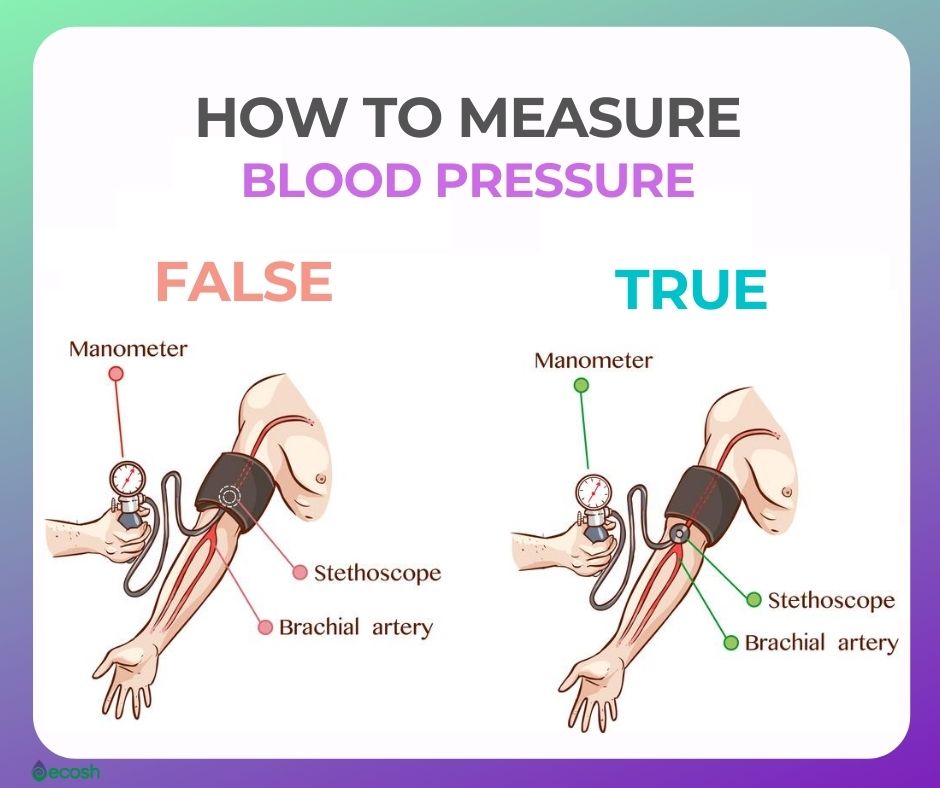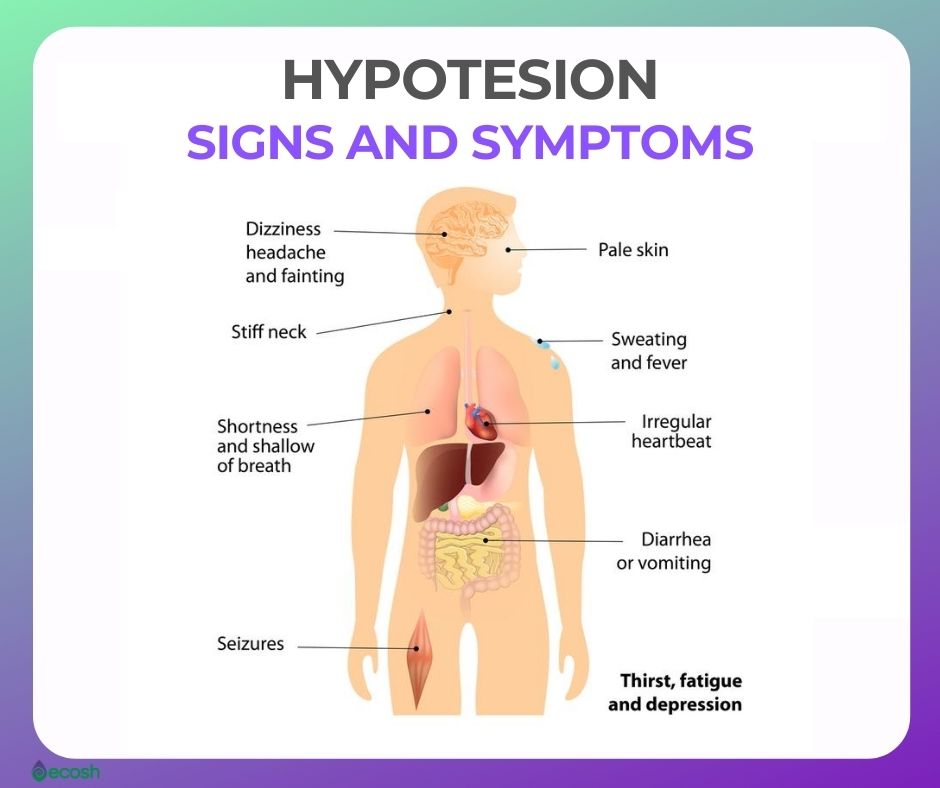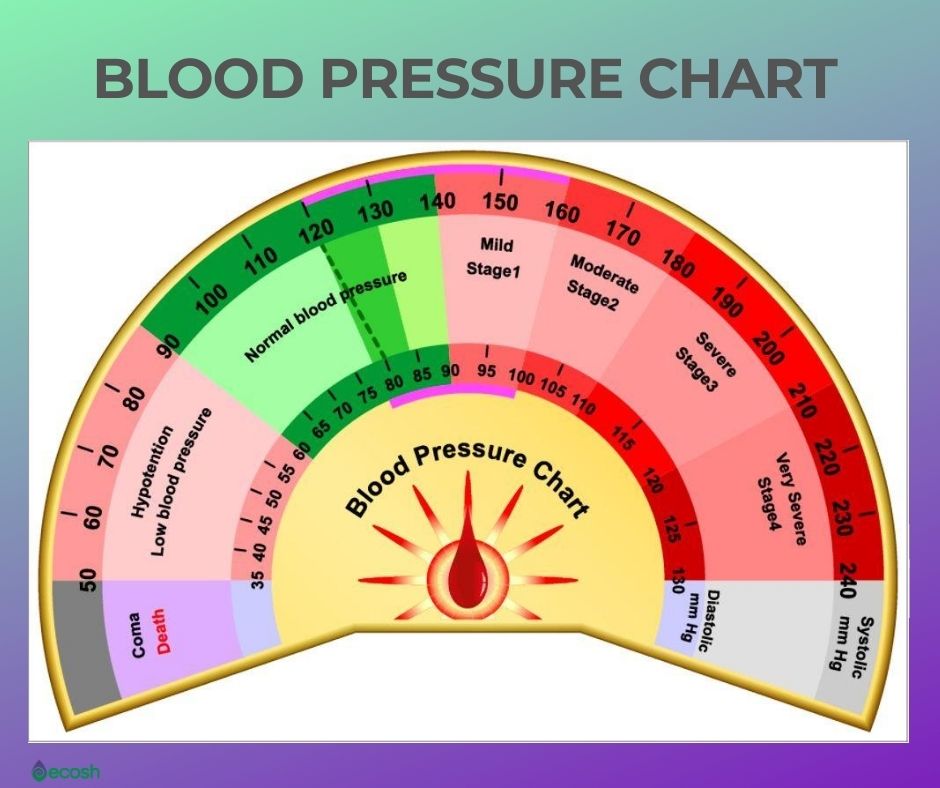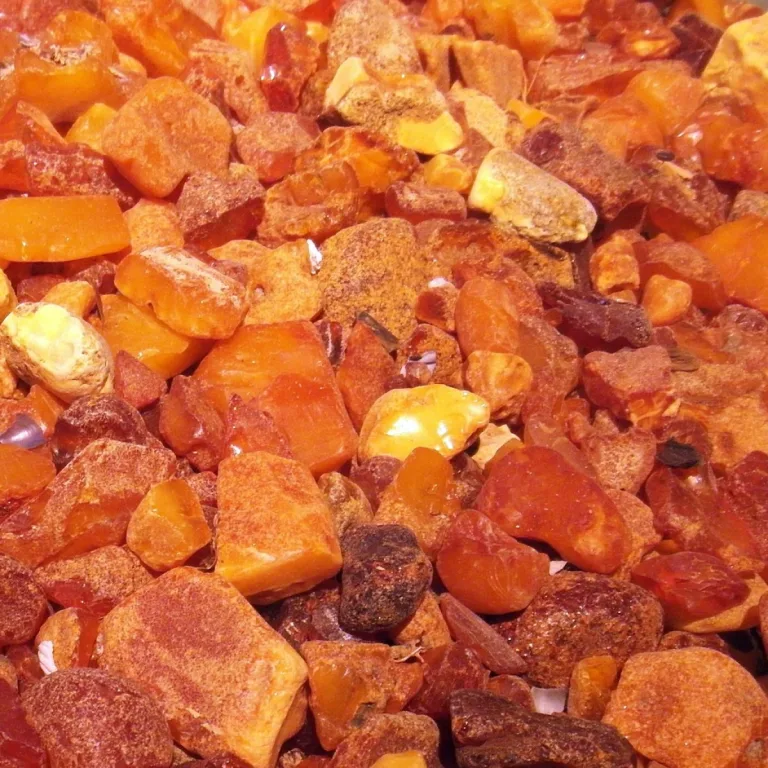Hypotension is also known as low blood pressure. It means that for some reason the blood pressure on the walls of the blood vessels is not enough to raise the pressure to the required level where the organ systems can be supplied with blood and thus oxygen.
Your blood pressure values reveal the volume of blood pumped into the bloodstream by the heart and the tone of blood vessels. They show hard your blood is pushing against the sides of your blood vessels (arteries) as it travels around your body.
- The upper number, systolic blood pressure, shows the force your heart exerts on the walls of your blood vessels each time it beats.
- The lower number, diastolic blood pressure, shows the force your heart exerts on the walls of your blood vessels in between beats – during the relaxation phase.
Therefore, as it changes over time, blood pressure is not static but is affected by external factors such as activity levels but also by physiological changes such as diseases. However, there are people whose pressure is already naturally low. This may not cause them any problems on a daily basis, but their so-called buffer is significantly smaller.
Thus, if person who has daily blood pressure 100/85 mm Hg, a small change, a drop of just 15 mm Hg can cause him to have disturbances of consciousness, while a person with 125/90 pressure does not feel a significant change in his overall well-being.
<120/80 mm Hg is considered optimal and low blood pressure officially starts> 90/60. The line between normal and low blood pressure is conventional and is often influenced by the individual’s characteristics.
The balance of the blood pressure is an important factor without which circulatory disorders would occur, because not enough blood will reach certain organ systems.

Blood Pressure – How to Measure?
- Blood pressure is measured with a sphygmomanometer, which can be either manual or automatic. The first is more common among medical professionals because it requires more skills. However, both measuring instruments have certain rules of use that should be followed in order to obtain a true result. In this case, we focus on the automatic device.
- The blood pressure monitor must be calibrated and the cuff must be in the correct size, i.e. cover 2/3 of the upper arm. The cuff must also be on the same line with the heart, in the right place (the artery mark on the cuff) and no clothes should be left under it.
- Before measuring, you should sit or lie down for a few minutes and avoid stressful situations, physical exertion, smoking and drinking coffee about half an hour before.
- Measure your blood pressure twice at intervals of a few minutes and, if the results differ greatly, repeat the measurement with your other hand, for example. However, preference should be given to the hand from which the higher values were obtained.
- Blood pressure changes over time, e.g. is lower at night and higher during exercise. For daily measurements, a specific time should be preferred in order to generate a reference moment.
- Record your blood pressure as well as your heart rate on a daily basis so that you can get a better overview of the average readings and react accordingly if necessary.
- Inaccurate measurements may be obtained in people with arrhythmias.
- If necessary, have the GP nurse teach you the correct measurement method.

Low Blood Pressure Hypotension
Hypotension is a low blood pressure, or blood pressure that is lower than normal. Hypotension as a disease is officially classified as> 90/60 mm Hg.
Blood pressure categories according to The American college of Cardiology:
- Low blood pressure. SBP <90 mm Hg and DBP <60 mm Hg.
- Normal blood pressure. SBP <120 mm Hg and DBP <80 mm Hg.
- Your blood pressure is optimal or normal if it’s below 120/80 mm Hg.
- Elevated blood pressure. SBP 120-129 mm Hg and DBP <80 mm Hg.
- Elevated blood pressure is a systolic pressure ranging from 120 to 129 mm Hg and a diastolic pressure below 80 mm Hg. Elevated blood pressure tends to get worse over time unless steps are taken to control blood pressure.
- Hypertension
- Stage 1 – SBP 130-139 mm Hg or DBP 80-89 mm Hg. This is a systolic pressure ranging from 130 to 139 mm Hg or a diastolic pressure ranging from 80 to 89 mm Hg.
- Stage 2 .- SBP >=140mm Hg or DBP >=90mm Hg. More severe hypertension, stage 2 hypertension is a systolic pressure of 140 mm Hg or higher or a diastolic pressure of 90 mm Hg or higher (1, 2).

Low Blood Pressure Hypotension – Symptoms
Symptoms of low blood pressure hypotension include:
- Weakness
- Imbalance
- Nausea
- Dizziness or lightheadedness
- Fainting
- Blurred or fading vision
- Fatigue
- Lack of concentration
- Loss of consciousness, which can lead to secondary damage. For example, if the pressure is too low, the brain may not receive enough oxygen, which can cause a person to lose consciousness and cause serious injuries if they fall.
Symptoms of shock – an extreme hypotension which may result in life-threatening condition include:
- Confusion, especially in older people
- Cold, clammy, pale skin
- Rapid, shallow breathing
- Weak and rapid pulse (4).

Low Blood Pressure Hypotension – The Risk Factors and Causes
The reason for low blood pressure is not always clear. However, it may be linked with the following:
- Low blood pressure is usually an individual and congenital condition that can be normal for a given person. It can be a problem if it has never happened before in your life.
- Aside from traumatic causes, a temporary drop in blood pressure can be caused by a lack of water, which also affects the electrolyte balance.
- In addition to mineral deficiency, also B12 and folic acid deficiency can affect blood pressure by lowering it.
- Some over-the-counter medications can also cause low blood pressure hypotension.
- Pregnancy, which is usually reversible after childbirth, can also lower blood pressure.
- Low blood pressure can also be a symptom of certain endocrine diseases. Here, too, the key activities of a healthy lifestyle are important factors.
- According to WebMd the causes can also be heat exhaustion or heat stroke.
- Liver disease.
- Hormonal problems.
- Underactive thyroid (hypothyroidism).
- Diabetes, or low blood sugar (hypoglycemia).
- Some prescription medicines such as for depression, Parkinson’s disease or high blood pressure.
- Heart failure.
- Heart arrhythmias (abnormal heart rhythms).
- Widening, or dilation of the blood vessels.
Sudden Fall in Blood Pressure – Causes
Sudden drops in blood pressure can be life-threatening, because for example you can fall down and badly hit your head. According to WebMD, causes of this type of hypotension may include:
- High body temperature or low body temperature.
- Heart muscle disease that cause heart failure.
- Loss of blood from bleeding.
- Sepsis, which is a severe blood infection.
- A reaction to alcohol.
- Severe dehydration from diarrhea, fever or vomiting.
- A reaction to some medication.
- A severe allergic reaction (anaphylaxis) that causes an irregular heartbeat.

Types of Low Blood Pressure
According to Mayoclinic, doctors often divide low blood pressure (hypotension) into categories, depending on the causes and other factors. Hypotension types include:
- Orthostatic or Postural Hypotension – Low blood pressure on standing up.
- Postprandial Hypotension – Means that blood pressure is lower after eating.
- Neurally Mediated Hypotension – Low blood pressure because of faulty brain signals.
- Orthostatic or Postural Hypotension – Low blood pressure due to nervous system damage.
Orthostatic or Postural Hypotension
Postural hypotension is low blood pressure when, for example, standing up suddenly from a sitting position or after lying down. It happens because gravity causes blood to pool in your legs when you stand. Normally, your body balances it by boosting your heart rate and constricting blood vessels, thereby securing that sufficient amount of blood returns to your brain.
However, in people with postural hypotension, this balancing mechanism fails and blood pressure drops, leading to blurred vision, dizziness, lightheadedness, and sometimes even fainting.
Postural hypotension may mostly occur in people who are taking drugs to control high blood pressure (hypertension). The elderly are especially affected, particularly those who have high blood pressure or autonomic nervous system dysfunction.
However, according to WebMD and Mayoclinic, naturally occurring postural hypotension can happen to anyone for a several of common reasons such as for example:
- Standing up suddenly after sitting with legs crossed for long periods or after squatting for a time.
- Electrolyte loss and dehydration, which may be commonly caused by vomiting, excessive blood loss during menstruation, diarrhea or other conditions.
- Certain diseases such as central nervous system disorders (such as Shy-Drager syndrome or multiple system atrophy), nerve problems (such as peripheral neuropathy or autonomic neuropathy), cardiovascular disorders, alcoholism and nutritional diseases.
- Burns.
- Excessive heat.
- Large varicose veins.
- Prolonged bed rest.
- Lack of food.
- Being overly fatigued.
- It can also be influenced by aging and age-associated decline in blood pressure regulation, which may be worsened by certain health conditions or medications.
- Psychological and dietary factors.
- Acute triggers, such as infection and allergy.
- Pregnancy.
- It can also be related to strong emotions.
- Hardening of the arteries (atherosclerosis).
- Diabetes.
- Some medication. These medications can be divided into two major categories:
- Drugs used to treat high blood pressure, such as beta-blockers, calcium-channel blockers, angiotensin-converting enzyme (ACE) inhibitors and diuretics.
- Drugs that have hypotension as a side effect, such as anti-anxiety agents, nitrates, erectile dysfunction medications, drugs for Parkinson’s disease, neuroleptics, sedative-hypnotics, tricyclic antidepressants and antipsychotics.
Postprandial Hypotension
Low blood pressure (hypotension) after eating is a common cause of dizziness and falls after eating. This is most common after huge meals that contain a lot of carbohydrates such as dairy products, fruits, grains, legumes, sugary sweets, bread, and starchy vegetables such as potatoes, rice and pasta.
It happens because blood flows to your digestive tract (into the vessels of the intestines and stomach) after you eat. Normally, your body boosts your heart rate and constricts certain blood vessels to help maintain normal blood pressure. But in some people these mechanisms do not work as they should, causing dizziness, faintness and falls. The fall in blood pressure usually occurs one to two hours after eating and affects mostly older adults.
Postprandial hypotension more likely affects people with high blood pressure or autonomic nervous system disorders such as Parkinson’s disease.
However, if you choose small, low-carbohydrate meals, drink more fluids (preferably water), and avoid alcohol, you might reduce these uncomfortable symptoms.
Neurally Mediated Hypotension
Neurally mediated hypotension is low blood pressure because of faulty brain signals, which causes a blood pressure fall after standing for long periods. For the most part it affects children and young adults and seems to happen because of a miscommunication between the brain and the heart.
Multiple System Atrophy with Orthostatic Hypotension (Shy-Drager Syndrome)
This rare disorder, also called Shy-Drager syndrome, is a low blood pressure because of the damage of the nervous system (multiple system atrophy with orthostatic hypotension). It has many symptoms that are similar to Parkinson disease, and it causes increasing damage to the autonomic nervous system.
12 Tips to Treat Low Blood Pressure Hypotension – Hypotension Diet, Medication, Dietary Supplements and Lifestyle Changes for Low Blood Pressure
Along with conventional treatment, by starting a few new food and lifestyle habits you may be able to increase your blood pressure. However, low blood pressure that causes only mild symptoms or doesn’t cause any symptoms rarely needs treatment.
Though, if you have symptoms that disturb you, treatment depends on the cause. For instance, when the low blood pressure is caused by some medication, treatment usually involves reducing the dose or stopping or switching the medication.
According to WebMD and Mayoclinic, depending on the reason for your low blood pressure, your health, age, and the type of low blood pressure, you might be able to reduce or prevent hypotension symptoms in several ways.
Dietary changes to balance blood pressure – hypotension diet
- Use more salt (sodium). A high-salt diet increases blood pressure, sometimes dramatically (5). For people with hypotension, that can be a great news. However, try to pick more healthy options of salty food such as pickled items, olives, salted fish, canned soup, smoked fish, and cottage cheese. However, because excess sodium can lead to heart failure, especially in older adults, it’s important to talk with your physician before increasing the salt in your menu.
- Water and other fluids. Dehydration reduces blood volume, causing blood pressure to fall. Water and fluids on the other hand, increase blood volume and help prevent dehydration. Staying hydrated is particularly important when you exercise.
- Drink less alcohol. Alcohol can lower blood pressure even if you drink in moderation, because it has dehydrating ability.
- Small meals. Eating small portions several times a day instead one or two huge meals helps prevent blood pressure from falling sharply after meals.
- Low-carb meals. Foods that are high in carbohydrates, particularly processed carbs, tend to digest very quickly relative to other foods. This may lead to sudden fall in blood pressure. A low-carb diet has been shown in some studies to help with off-setting hypotension, especially in older adults. So try to avoid high-carbohydrate foods such as bread, sugary sweets, dairy products, fruits, grains, legumes, and starchy vegetables such as potatoes, rice and pasta.
- Caffeine. Caffeinated tea and coffee stimulate the cardiovascular system and boost your heart rate. Therefore these drinks may temporarily elevate your blood pressure. However, while doctors may suggest to drink caffeine drinks in morning, don’t drink it throughout the day because caffeine may cause dehydration, and you may also become less sensitive to caffeine (3, 4, 5).
Medication and dietary supplements
- Medications. There are many medications doctors suggest for the treatment of postural hypotension (low blood pressure when you stand up suddenly). For example, fludrocortisone, that boosts your the volume of your blood. Often also midodrine (Orvaten) to raise standing blood pressure levels in people with chronic postural hypotension. It works by limiting the capability of your blood vessels to expand (expanding vessels escalate blood pressure).
- Vitamin B-12. B-12 deficiency can lead to a certain type of anemia. Which in turn, may cause low blood pressure. To help prevent B-12 deficiency eat foods that are high in B-12 such as animal meats, fish, eggs, nutritional yeast or fortified cereals. You are at risk developing B-12 deficiency if you are vegetarian, as B-12 naturally occurs only in animal foods.
- Folate. Deficiency of folate can also play a role in causing anemia. If you suspect folate deficiency, consume more folate-rich foods such as leafy greens, beans, asparagus, lentils, citrus fruits, liver, and eggs (3, 4, 5).
Lifestyle changes and for exercise
- Compression stockings. Although these elastic stockings are mainly used to lessen the swelling and pain of varicose veins, compression stockings can also help reduce the pooling of blood in your legs.
- Exercise. Exercising at least 30 to 60 minutes a day two or three days a week raises your heart rate and resistance. However, you should not exercise in humid or hot conditions (3, 4, 5).
- Body positions. According to The Medifit Education, there are also some moves that stimulate blood flow from your legs to your heart. For example:
- Stand up gradually. Especially in the mornings when waking up. For example, stretch in bed before you get up, or try other physical movements first to increase your heart rate and the flow of blood around your body.
- Gently move from a prone or squatting to a standing position.
- Don’t sit with your legs crossed.
- Cross and uncross your legs if you are sitting and are about to stand.
- If you start to have low blood pressure symptoms while standing, put one foot on a ledge or chair and lean as far forward as possible, or cross your thighs in a scissors fashion and squeeze (7).
Blood Pressure – Prevention and Control
High blood pressure usually indicates an increased risk of cardiovascular disease. Therefore, to reduce the risk of heart attacks and strokes, it is very important to keep your blood pressure within the normal range. By reducing the risk factors for high blood pressure, you can also have a positive effect on blood pressure by keeping it stably in the normal range.
Ensuring normal blood pressure is critical to maintain and promote good health. To prevent high blood pressure, you should start checking it more regularly if you are over 40 years old, have close relatives with high blood pressure, and if you have a history of high blood pressure or have had a high blood pressure.
Cultivating a healthy lifestyle is the main thing you can do yourself to improve your overall health and thus keep your blood pressure stable at normal values for longer. As this indicator may inevitably increase with age, it is important to visit your doctor regularly, who will prescribe medicines that affect your blood pressure if necessary.
NB! The information provided here is for informational purposes only and should not be construed as health care or medical diagnosis and treatment. This information should not be construed as a guarantee of the results to be achieved. In addition, this information is not intended to replace the advice of your physician or other healthcare professional.
Even more, you should not use it to diagnose or treat a health problem. Before changing or discontinuing your existing medication, treatment, or care, or taking any dietary supplements, be sure to consult with your healthcare professional or doctor before starting any diet or program, or if you suspect you may have a medical condition.
Compiled by Maria-Helena Loik
Pictures: Pexels.com, Pixabay.com, Shutterstock.com
Sources:
- https://www.mayoclinic.org/diseases-conditions/high-blood-pressure/diagnosis-treatment/drc-20373417
- https://gpnotebook.com/simplepage.cfm?ID=x20040318171757418550
- https://www.webmd.com/heart/understanding-low-blood-pressure-basics#2
- https://www.mayoclinic.org/diseases-conditions/low-blood-pressure/symptoms-causes/syc-20355465
- https://www.healthline.com/health/low-blood-pressure-diet#takeaway
- https://manhattancardiology.com/what-to-eat-to-help-raise-low-blood-pressure/
- http://themedifit.com/hypotension-low-blood-pressure/


